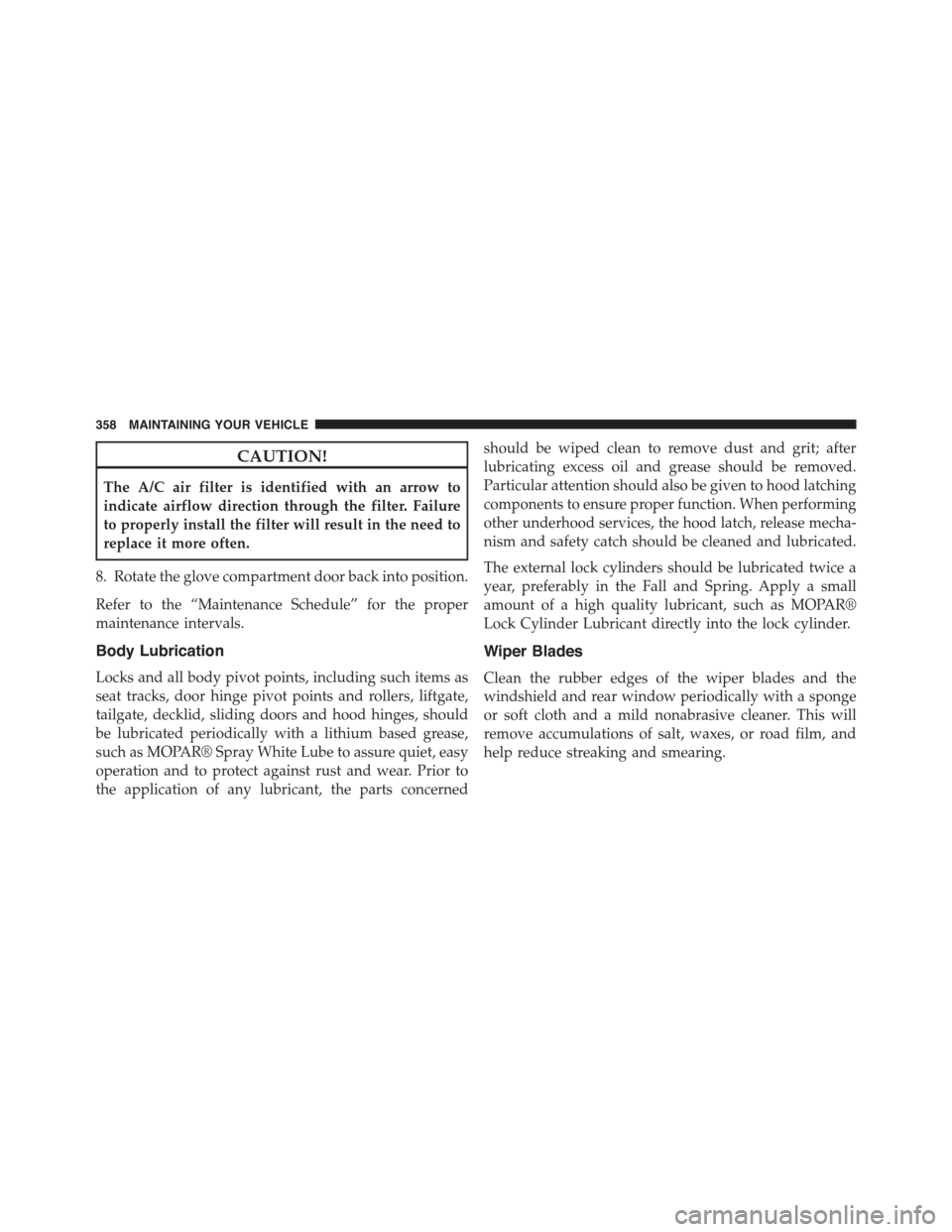Page 112 of 438
•For proper routing of a Child Seat Tether, refer to
“Occupant Restraints” in “Things to Know Before
Starting Your Vehicle”
WARNING!
The head restraints for all occupants must be prop-
erly adjusted before operating the vehicle or occupy-
ing a seat. Head restraints should never be adjusted
while the vehicle is in motion. Driving a vehicle with
the head restraints improperly adjusted or removed
could cause serious injury or death in the event of an
accident.
OPENING AND CLOSING THE HOOD
To open the hood, two latches must be released to open
the hood.
1. Pull the hood release lever located under the left side
of the instrument panel.
Hood Release Lever
11 0 U N D E R S TA N D I N G T H E F E AT U R E S O F Y O U R V E H I C L E
Page 360 of 438

CAUTION!
The A/C air filter is identified with an arrow to
indicate airflow direction through the filter. Failure
to properly install the filter will result in the need to
replace it more often.
8. Rotate the glove compartment door back into position.
Refer to the “Maintenance Schedule” for the proper
maintenance intervals.
Body Lubrication
Locks and all body pivot points, including such items as
seat tracks, door hinge pivot points and rollers, liftgate,
tailgate, decklid, sliding doors and hood hinges, should
be lubricated periodically with a lithium based grease,
such as MOPAR® Spray White Lube to assure quiet, easy
operation and to protect against rust and wear. Prior to
the application of any lubricant, the parts concerned
should be wiped clean to remove dust and grit; after
lubricating excess oil and grease should be removed.
Particular attention should also be given to hood latching
components to ensure proper function. When performing
other underhood services, the hood latch, release mecha-
nism and safety catch should be cleaned and lubricated.
The external lock cylinders should be lubricated twice a
year, preferably in the Fall and Spring. Apply a small
amount of a high quality lubricant, such as MOPAR®
Lock Cylinder Lubricant directly into the lock cylinder.
Wiper Blades
Clean the rubber edges of the wiper blades and the
windshield and rear window periodically with a sponge
or soft cloth and a mild nonabrasive cleaner. This will
remove accumulations of salt, waxes, or road film, and
help reduce streaking and smearing.
358 MAINTAINING YOUR VEHICLE
Page 373 of 438

Brake System
In order to assure brake system performance, all brake
system components should be inspected periodically.
Refer to the “Maintenance Schedule” for the proper
maintenance intervals.
WARNING!
Riding the brakes can lead to brake failure and
possibly a collision. Driving with your foot resting or
riding on the brake pedal can result in abnormally
high brake temperatures, excessive lining wear, and
possible brake damage. Riding the brakes may also
reduce braking capacity in an emergency.
Brake Master Cylinder
The fluid level in the master cylinder should be checked
when performing under hood services, or immediately if
the “Brake Warning Light” is on.
Be sure to clean the top of the master cylinder area before
removing the cap. If necessary, add fluid to bring the
fluid level up to the requirements described on the brake
fluid reservoir. Fluid level can be expected to fall as the
brake pads wear. The brake fluid level should be checked
when the pads are replaced. However, low fluid level
may be caused by a leak and a checkup may be needed.
NOTE:If your vehicle is equipped with amanual trans-
mission, the brake fluid reservoir supplies fluid to both
the brake system and the clutch release system. The two
systems are separated in the reservoir, and a leak in one
system will not affect the other system. Themanual
transmissionclutch release system should not require
fluid replacement during the life of the vehicle. If the
brake fluid reservoir is low and the brake system does
not indicate any leaks or other problems, it may be a
result of a leak in the hydraulic clutch release system. See
your local authorized dealer for service.
7
MAINTAINING YOUR VEHICLE 371
Page 387 of 438
Underhood Fuses
The Front Distribution Unit is located on the right side of
the engine compartment, next to the battery. To access the
fuses, press the release tabs and remove the cover.
The ID number of the electrical component correspond-
ing to each fuse can be found on the back of the cover.
Front Distribution Unit
7
MAINTAINING YOUR VEHICLE 385
Page 428 of 438

Gasoline, Reformulated.....................299
Gauges
Coolant Temperature.....................169
Fuel.................................169
Odometer.............................175
Tachometer............................171
Gear Ranges.............................233
Gear Select Lever Override..................339
General Information.......................298
General Maintenance.......................175
Glass Cleaning...........................382
Hazard
Driving Through Flowing, Rising, or Shallow
Standing Water.........................252
Headlights..............................113
Cleaning.............................382
High Beam............................171
Passing..............................114
Heated Mirrors............................96
Hill Start Assist...........................260
Holder, Cup.............................150
HomeLink® (Garage Door Opener)............136
Hood Release............................110
Ignition
Key . . . . . . . . . . . . . . . . . . . . . . . . . . . . . . . . . .11
Immobilizer (Sentry Key)....................14
Information Center, Vehicle..................177
Inside Rearview Mirror......................92
Instrument Cluster........................167
Instrument Panel and Controls................165
Instrument Panel Cover.....................382
Instrument Panel Lens Cleaning...............383
Interior Appearance Care....................381
Interior Lighting..........................115
Introduction..............................4
426 INDEX